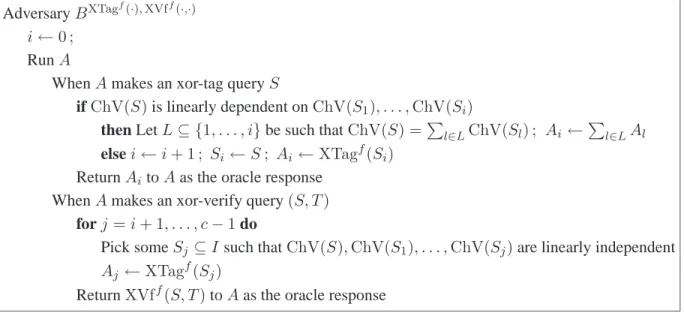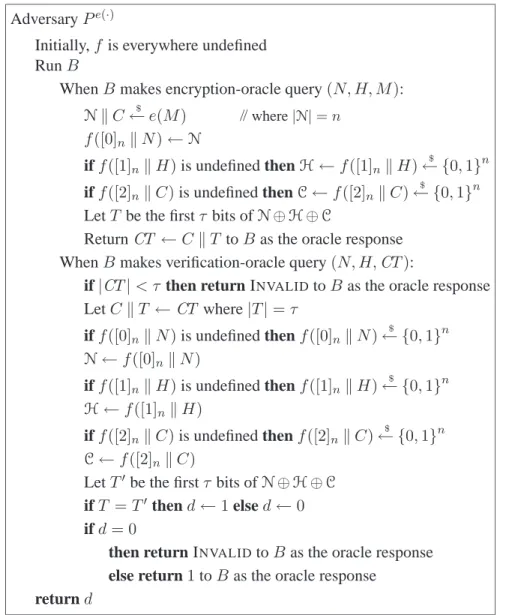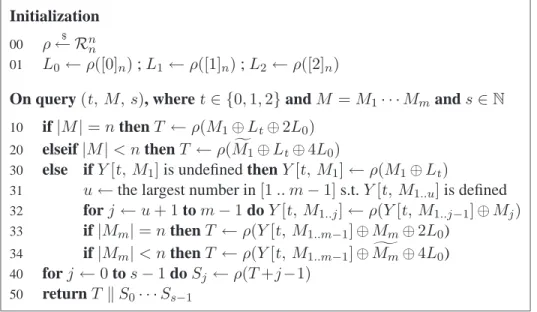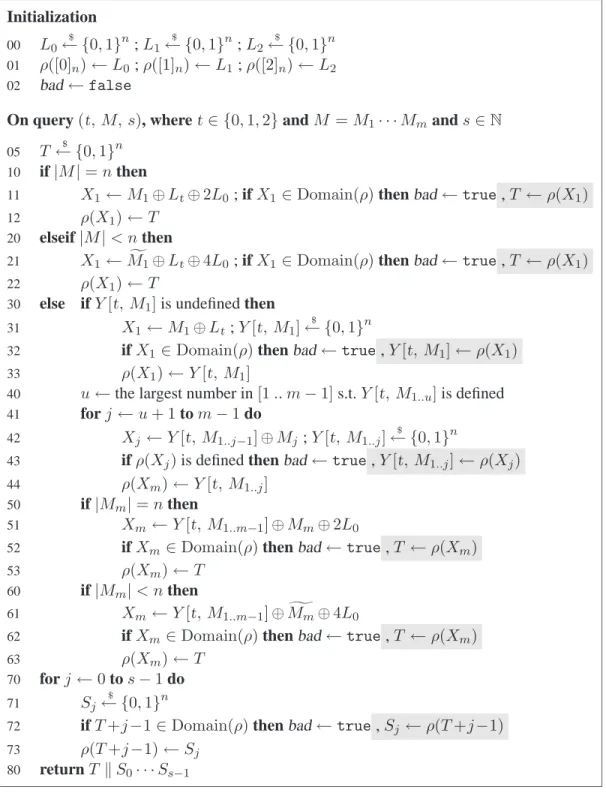A preliminary version of this papers appears in Fast Software Encryption ’04, Lecture Notes in Computer Science, vol. ?? , R. Bimal and W. Meier ed., Springer-Verlag, 2004. This is the full version.
The EAX Mode of Operation
(A Two-Pass Authenticated-Encryption Scheme Optimized for Simplicity and Efficiency)
M. BELLARE∗ P. ROGAWAY† D. WAGNER‡
January 18, 2004
Abstract
We propose a block-cipher mode of operation, EAX, for solving the problem of authenticated-encryption with associated-data (AEAD). Given a nonceN, a message M, and a headerH, our mode protects the privacy ofM and the authenticity of bothM andH. StringsN,M, andH are arbitrary bit strings, and the mode uses2|M|/n+|H|/n+|N|/nblock-cipher calls when these strings are nonempty andn is the block length of the underlying block cipher. Among EAX’s characteristics are that it is on-line (the length of a message isn’t needed to begin processing it) and a fixed header can be pre-processed, effectively removing the per-message cost of binding it to the ciphertext.
EAX is obtained by first creating a generic-composition method, EAX2, and then collapsing its two keys into one. EAX is provably secure under a standard complexity-theoretic assumption. The proof of this fact is novel and involved.
EAX is an alternative to CCM [26], which was created to answer the wish within standards bodies for a fully-specified and patent-free AEAD mode. As such, CCM and EAX are two-pass schemes, with one pass for achieving privacy and one for authenticity. EAX is simpler and more efficient than CCM, avoiding, for example, elaborate padding rules or nonstandard parameters. With EAX we aimed to do as well as possible, within the space of two-pass schemes, with regard to issues of efficiency, simplicity, elegance, ease of correct use, and provable-security guarantees.
Keywords: Authenticated encryption, CCM, EAX, message authentication, CBC MAC, modes of operation, OMAC, provable security.
∗Department of Computer Science & Engineering, University of California at San Diego, 9500 Gilman Drive, La Jolla, California 92093, USA. E-mail:mihir@cs.ucsd.edu WWW:www-cse.ucsd.edu/users/mihir/
†Department of Computer Science, University of California at Davis, Davis, California 95616, USA; and Department of Computer Science, Faculty of Science, Chiang Mai University, Chiang Mai 50200, Thailand. E-mail:rogaway@cs.ucdavis.edu WWW:
www.cs.ucdavis.edu/˜rogaway/
‡Department of Electrical Engineering and Computer Science, University of California at Berkeley, Berkeley, California 94720, USA. E-mail:daw@cs.berkeley.edu WWW:http://www.cs.berkeley.edu/˜daw/
Contents
1 Introduction 3
2 Preliminaries 5
3 The EAX Algorithm 6
4 Intellectual Property Statement 9
5 EAX2 Algorithm 9
6 Definitions 11
7 Security Results 13
8 Acknowledgments 15
A Definition of CCM 17
B Criticism of CCM 17
B.1 Efficiency issues . . . 17
B.2 Parameterization . . . 19
B.3 Complexity . . . 20
B.4 Subtleties of variable-length authentication tags . . . 21
B.5 Security claims . . . 22
C Proof of Security of EAX2 22
D Proof of Security ofOMAC 28
E Proof of Security of EAX 36
F Recommended API 38
G Test Vectors 43
1 Introduction
An authenticated encryption (AE) scheme is a symmetric-key mechanism by which a messageM is a trans- formed into a ciphertext CT with the goal thatCT protect both the privacy and the authenticity of M. The last few years has seen the emergence of AE as a recognized cryptographic goal. With this has come the de- velopment of new authenticated-encryption schemes and the analysis of old ones. This paper offers up a new authenticated-encryption scheme, EAX, and provides a thorough analysis of it. To understand why we are defining a new AE scheme, we need to give some background.
FLAVORS OF AUTHENTICATED ENCRYPTION. It useful to distinguish two kinds of AE schemes. In a two-pass scheme we make two passes through the data, one aimed at providing privacy and the other, authenticity. One way of making a two-pass AE scheme is by generic composition, wherein one pass constitutes a (privacy-only) symmetric-encryption scheme, while the other pass is a message authentication code (MAC). The encryption scheme and the MAC each use their own key. Analyses of some generic composition methods can be found in [5, 6, 20].
In a one-pass AE scheme we make a single pass through the data, simultaneously doing what is needed to engender both privacy and authenticity. Typically, the computational cost is about half that of a two-pass scheme. Such schemes emerged only recently. They include IAPM, OCB, and XCBC [12, 17, 25].
Soon after the emergence of one-pass AE schemes it was realized that often not all the data should be privacy-protected. Changes were needed to the basic definitions and mechanisms in order to support the pos- sibility that some information, like a packet header, must not be encrypted. Thus was born the notion of authenticated-encryption with associated-data (AEAD), first formally defined in [24]. The non-secret data is called the associated data or the header. Like an AE schemes, an AEAD scheme might make one pass or two.
STANDARDIZING A TWO-PASSAEAD SCHEME. Traditionally, it has been the designers of applications and network protocols who were responsible for combining privacy and authenticity mechanisms in order to make a two-pass AEAD scheme. This has not worked well. It turns out that there are numerous ways to go wrong in trying to make a secure AEAD scheme, and many protocols, products, and standards have done just that. (For example, see [11] for a wrong one-pass scheme, see [5] for weaknesses in the AEAD mechanism of SSH, and [6, 20] for attacks on some methods of popular use.)
Nowadays, some standards bodies (including NIST, IETF, and IEEE 802.11) would like to standardize on an AEAD scheme. Indeed IEEE 802.11 has already done so. This is a good direction. Standardized AEAD might help minimize errors in mis-combining cryptographic mechanisms.
So far, standards bodies have been unwilling to standardize on any of the one-pass schemes due to pending patents covering them. There is, accordingly, an established desire for standardizing on a two-pass AEAD scheme. The two-pass scheme should be as good as possible subject to the limitation of falling within the two-pass framework.
Generic-composition would seem to be the obvious answer. But defining a generic-composition AEAD scheme is not an approach that has moved forward within any of the standards bodies. There would seem to be a number of reasons. One reason is a relatively minor inefficiency—the fact that generic composition methods must use two keys. Probably a bigger issue is that the architectural advantage of generic composition brings with it an “excessive” degree of choice—after deciding on a generic composition method, one still needs two lower-level specifications, namely a symmetric encryption scheme and a MAC, for each of which numerous block-cipher based choices exist. Standards bodies want something self-contained, as well as being a patent- avoiding, block-cipher based, single-key mechanism.
So far, there has been exactly one proposal for such a method (though see the “contemporaneous work”
section below). It is called CCM [26], and is due to Whiting, Housley, and Ferguson [26]. CCM has enjoyed rapid success, and is now the required mechanism for IEEE 802.11 wireless LANs as well as 802.15.4 wireless personal area networks. NIST has indicated that it plans to put out a “Recommendation” based on CCM.
OUR CONTRIBUTIONS. It is our view that CCM has a good deal of pointless complexity and inefficiency. It is the first contribution of this paper to explain these limitations. It is the second and main contribution of this paper to provide a new AEAD scheme, EAX, that avoids these limitations.
CCMLIMITATIONS. A description of CCM, together with a detailed description of its shortcomings, can be found in Appendix A. Some of the points we make and elaborate on there are the following. CCM is not on-line, meaning one needs to know the lengths of both the plaintext and the associated data before one can proceed with encryption. This may be inconvenient or inefficient. CCM does not allow pre-processing of static associated data. (If, for example, we have an unchanging header attached to every packet being authenticated, we would like that the cost of authenticating this header be paid only once, meaning header authentication should have no significant cost after a single pre-computation. CCM fails to have this property.) CCM’s parameterization is more complex than necessary, including, in addition to the block cipher and tag length, a message-length parameter. CCM’s nonce length is restricted in such a way that it may not provide adequate security when nonces are chosen randomly. Finally, CCM implementations could suffer performance hits because the algorithm can disrupt word alignment in the associated data.
EAXAND ITS ATTRIBUTES. EAX is a nonce-using AEAD scheme employing no tool beyond the block cipher E: Key× {0,1}n→ {0,1}non which it is based. We expect thatEwill often be instantiated by AES, but we make no restrictions in this direction. (In particular we do not require thatn= 128.) Nothing is assumed about the nonces except that they are non-repeating. EAX provides both privacy, in the sense of indistinguishability from random bits, and authenticity, in the sense of an adversary’s inability to produce a new but validnonce, header, ciphertexttriple. EAX is simple, avoiding complicated length-annotation. It is a conventional two-pass AEAD scheme, making a separate privacy pass and authenticity pass, using no known intellectual property.
EAX is flexible in the functionality it provides. It supports arbitrary-length messages: the message space is{0,1}∗. The key space for EAX is the key spaceKeyof the underlying block cipher. EAX supports arbitrary nonces, meaning the nonce space is{0,1}∗. Any tag lengthτ ∈[0.. n]is possible, to allow each user to select how much security she wants from the authenticity guarantees. The only user-selectable parameters are the block cipherEand that tag lengthτ.
EAX has desirable performance attributes. Message expansion is minimal: the length of the ciphertext (which, following the conventions of [25], excludes the nonce) is onlyτ bits more than the length of the plain- text. Implementations can profitably pre-process static associated data. (If an unchanging header is attached to every packet, authenticating this header has no significant cost after a single pre-computation.) Key-setup is efficient: all block-cipher calls use the same underlying key, so that we do not incur the cost of key scheduling more than once. For both encryption and decryption, EAX uses only the forward direction of the block cipher, so that hardware implementations do not need to implement the decryption functionality of the block cipher.
The scheme is on-line for both the plaintextM and the associated dataH, which means that one can process streaming data on-the-fly, using constant memory, not knowing when the stream will stop.
PROVABLE SECURITY. We prove that EAX is secure assuming that the block cipher that it uses is a secure pseu- dorandom permutation (PRP). Security for EAX means indistinguishability from random bits and authenticity of ciphertexts. The combination implies other desirable goals, like nonmalleability and indistinguishability under a chosen-ciphertext attack.
The proof of security for EAX is surprisingly complex. The key-collapse of EAX2 destroys a fundamental abstraction boundary. Our security proof relies on a result about the security of a tweakable extension of OMAC (Lemma 4) in which an adversary can obtain not only a tag for a message of its choice, but also an associated key-stream.
PRAGMATICS. The main reason there is any interest in two-pass schemes, as we have already discussed, is that one-pass schemes would seem to be subject to patents. Motivated by this, standardization bodies have expressed the intent of standardizing on a conventional, two-pass scheme, even understanding the factor-of-two
performance hit. The merit of this judgment is debatable, but the pragmatic reality is that there has emerged a desire for a conventional scheme, like EAX, that is as good as possible subject to the two-pass constraint. Lack of a scheme like EAX will simply lead to an inferior scheme being standardized, which is to the disadvantage of the user community. Accordingly, EAX addresses a real and practical design problem. We took up work on this design problem at the suggestion of the co-Chair of the IRTF (Internet Research Task Force), which supports the standardization efforts of the IETF. We believe that EAX has the potential for widespread adoption and use.
AFTERWARDS. One non-goal of EAX was to be parallelizable. Another recent two-pass design, CWC [19], is parallelizable. It pays for this advantage with a somewhat complex algorithm, based on Carter-Wegman hashing using polynomial evaluation over a prime field. More recent still is GCM [22], a parallelizable, two-pass design based on multiplication in the finite field with2128elements.
Other recent AEAD mechanisms include Helix [10] and SOBER-128 [13]. These are stream ciphers that aim to provide authenticity. The provable-security methodology does not apply to these objects since they are built directly rather than from lower level primitives.
2 Preliminaries
All strings in this paper are over the binary alphabet{0,1}. ForLa set of strings andn≥0a number, we letLn andL∗have their usual meanings. The concatenation of stringsXandY is denotedXY or simplyX Y. The string of length 0, called the empty string, is denotedε. IfX ∈ {0,1}∗we let|X|denote its length, in bits. If X ∈ {0,1}∗and≤ |X|then the firstbits ofXare denotedX[firstbits]. The set BYTE={0,1}8contains all the strings of length 8, and a stringX∈BYTE∗is called a byte string or an octet string. IfX∈BYTE∗ we letX8 =|X|/8denote its length in bytes. For≥1a number, we write BYTE<for all byte strings having fewer than bytes. If X ∈ BYTE∗ and ≤ Xn then the firstbytes ofX are denotedX [firstbytes].
WhenX ∈ {0,1}n is a nonempty string andt ∈ Nis a number we letX+tbe the n-bit string that results from regardingXas a nonnegative numberx(binary notation, most-significant-bit first), addingxtot, taking the result modulo2n, and converting this number back into ann-bit string. Ift ∈[0..2n−1]we let[t]ndenote the encoding oftinto ann-bit binary string (msb first, lsb last). IfX andP are strings then we letX ⊕→ P (the xor-at-the-end operator) denote the string of length= max{|X|,|P|}bits that is obtained by prepending |X| − |P|zero-bits to the shorter string and then xoring this with the other string. (In other words, xor the shorter string into the end of the longer string.) A block cipher is a function E: Key× {0,1}n → {0,1}n whereKeyis a finite, nonempty set andn≥1is a number andEK(·) =E(K,·)is a permutation on{0,1}n. The numbernis called the block length. Throughout this note we fix such a block cipherE.
In Figure 1 we define the algorithms CBC, CTR,pad, OMAC (no superscript), and OMAC• (with super- script). The algorithms CBC (the CBC MAC) and CTR (counter-mode encryption) are standard. Algorithm padis used only to define OMAC. Algorithm OMAC [14] is a pseudorandom function (PRF) that is a one- key variant of the algorithm XCBC [9]. Algorithm OMAC• is like OMAC but takes an extra argument, the integert. This algorithm is a “tweakable” PRF [21], tweaked in the most simple way possible.
We explain the notation used in the definition of OMAC. The value ofiL(line 40:ian integer in{2,4}and L∈ {0,1}n) is then-bit string that is obtained by multiplyingLby then-bit string that represents the numberi.
The multiplication is done in the finite fieldGF(2n)using a canonical polynomial to represent field points. The canonical polynomial we select is the lexicographically first polynomial among the irreducible polynomials of degree nthat have a minimum number of nonzero coefficients. Forn = 128 the indicated polynomial is x128+x7+x2+x+ 1. In that case,2L =L<<1if the first bit ofLis0and2L= (L<<1)⊕012010000111 otherwise, whereL<<1means the left shift ofLby one position (the first bit vanishing and a zero entering into the last bit). The value of4Lis simply2(2L). We warn that to avoid side-channel attacks one must implement the doubling operation in a constant-time manner.
Algorithm CBCK (M)
10 LetM1· · ·Mm←M where|Mi|=n 11 C0←0n
12 fori←1tomdo
13 Ci←EK(Mi⊕Ci−1) 14 returnCm
AlgorithmCTRNK (M) 20 m← |M|/n
21 S←EK(N)EK(N+1) · · · EK(N+m−1) 22 C←M ⊕ S[first|M|bits]
23 returnC
Algorithmpad(M; B, P) 30 if|M| ∈ {n,2n,3n, . . .} 31 then returnM ⊕→ B,
32 else return(M10n−1−(|M|modn)) ⊕→ P
AlgorithmOMACK(M)
40 L←EK(0n); B←2L; P ←4L 41 return CBCK(pad(M; B, P)) AlgorithmOMACKt (M)
50 returnOMACK([t]nM)
Figure 1: Basic building blocks. The block cipherE: Key× {0,1}n → {0,1}nis fixed andK∈Key. ForCBC, M ∈ ({0,1}n)+. ForCTR,M ∈ {0,1}∗ andN ∈ {0,1}n. Forpad, M ∈ {0,1}∗ and B, P ∈ {0,1}n and the operation⊕→xors the shorter string into the end of longer one. ForOMAC,M ∈ {0,1}∗andt∈[0..2n−1]and the multiplication of a number by a stringLis done inGF(2n).
We have made a small modification to the OMAC algorithm as it was originally presented, changing one of its two constants. Specifically, the constant 4 at line 40 was the constant 1/2 (the multiplicative inverse of 2) in the original definition of OMAC [14]. The OMAC authors indicate that they will promulgate this modification [15], which slightly simplifies implementations.
3 The EAX Algorithm
ALGORITHM. Fix a block cipherE: Key× {0,1}n→ {0,1}nand a tag lengthτ ∈[0..n]. These parameters should be fixed at the beginning of a particular session that will use EAX mode. Typically, the parameters would be agreed to in an authenticated manner between the sender and the receiver, or they would be fixed for all time for some particular application. Given these parameters, EAX provides a nonce-based AEAD scheme EAX[E, τ]whose encryption algorithm has signatureKey×Nonce×Header×Plaintext → Ciphertextand whose decryption algorithm has signature Key×Nonce×Header×Ciphertext → Plaintext∪ {INVALID} whereNonce,Header, Plaintext, andCiphertextare all {0,1}∗. The EAX algorithm is specified in Figure 2 and a picture illustrating EAX encryption is given in Figure 3. We now discuss various features of our algorithm and choices underlying the design.
NO ENCODINGS. We have avoided any nontrivial encoding of multiple strings into a single one.1 Some other approaches that we considered required a PRF to be applied to what was logically a tuple, like (N, H, C).
Doing this raises encoding issues we did not want to deal with because, ultimately, there would seem to be no simple, efficient, compelling, on-line way to encode multiple strings into a single one. Alternatively, one could avoid encodings and consider a new kind of primitive, a multi-argument PRF. But this would be a non-standard tool and we didn’t want to use any non-standard tools. All in all, it seemed best to find a way to sidestep the need to do encodings.
1One could view the prefixing of[t]ntoM in the definition ofOMACKt(M)as an encoding, but[t]nis a constant, fixed-length string, and the aim here is just to “tweak” the PRF. This is very different from needing to encode arbitrary-length strings into a single string.
Algorithm EAX.EncryptN HK (M)
10 N←OMACK0(N)
11 H←OMACK1(H)
12 C←CTRNK(M)
13 C←OMACK2(C)
14 Tag ←N⊕C⊕H
15 T ←Tag [firstτ bits]
16 returnCT ←CT
Algorithm EAX.DecryptN HK (CT)
20 if|CT|< τ then return INVALID 21 LetCT ←CT where|T|=τ
22 N←OMACK0(N)
23 H ←OMACK1(H)
24 C←OMACK2(C)
25 Tag←N⊕C⊕H
26 T ←Tag [firstτ bits]
27 ifT =Tthen return INVALID 28 M ←CTRNK(C)
29 returnM
Figure 2: Encryption and decryption underEAXmode. The plaintext isM, the ciphertext isCT, the key isK, the nonce isN, and the header isH. The mode depends on a block cipherE(that CTR and OMAC implicitly use) and a tag lengthτ.
N
T OMACK0
C
H M
N
H C
CTRK
OMACK1
OMACK2
Figure 3: Encryption underEAX. The message is M, the key isK, and the header isH. The ciphertext is CT =CT.
WHY NOT GENERIC COMPOSITION? Why have we specified a block-cipher based (BC-based) AEAD scheme instead of following the generic-composition approach of combining a (privacy-only) encryption method and
CCM EAX
Functionality AE with AD AE with AD
Built from Block cipherEwith 128-bit blocksize Block cipherEwithn-bit blocksize
Parameters Block cipherE
Tag lengthτ ∈ {4,6,8,10,12,14,16}
Length of message length fieldλ∈[2..8]
Block cipherE Tag lengthτ∈[0..n]
Message space Parameterized: 7 choices: λ ∈ [2..8].
Each possible message space a sub- set of BYTE∗, from BYTE216−1 to BYTE<264−1
{0,1}∗
Nonce space Parameterized, with a value of 15−λ bytes. From 56 bits to 104 bits
{0,1}∗
Key space One block-cipher key One block-cipher key
Ciphertext expansion τ bytes τbits
Block-cipher calls 2 |M|
128
+
|H|
128
+ 2 +δ, forδ∈ {0,1} 2 |M|
n
+
|H|
n
+
|N|
n
Block-cipher calls with static header
2 |M|
128
+
|H|
128
+ 2 +δ, forδ∈ {0,1} 2 |M|
n
+
|N| n
Key setup Block cipher subkeys Block cipher subkeys
3 block-cipher calls IV requirements Non-repeating nonce Non-repeating nonce
Parallelizable? No No
On-line? No Yes
Preprocessing (/msg) Limited (key stream) Limited (key stream, header)
Memory rqmts Small constant Small constant
Provable security? Yes (ifEis a good PRP) Bound ofΘ(σ2/2128)
Yes (ifEis a good PRP) Bound ofΘ(σ2/2n)
Patent-encumbered? No No
Figure 4: A comparison of basic characteristics of CCM andEAX. The count on block-cipher calls forEAX ignores key-setup costs. We denote byτ the length of the EAXtag in bits, and byτ (boldface) the length of theCCMtag in bytes.
a message authentication code? In fact, there are reasonable arguments in favor of generic composition, based on aesthetic or architectural sensibilities. One can argue that generic composition better separates conceptually independent elements (privacy and authenticity) and, correspondingly, allows greater implementation flexibil- ity [6, 20]. Correctness becomes much simpler and clearer as well. All the same, BC-based AEAD modes have some important advantages of their own. They make it easier for implementors to use a scheme without knowing a lot of cryptography, presenting a simpler abstraction boundary. They make it easier to obtain inter- operably. They reduce the risk that implementors will choose insecure parameters. They can save on key bits and key-setup time, as generic-composition methods invariably require a pair of separate keys.
EAX can be viewed as having been derived from a generic-composition scheme we call EAX2, described in Section 5. Specifically, one instantiates EAX2 using CTR mode (counter mode) and OMAC, and then collapses the two keys into one. If one favors generic composition, EAX2 is a nice algorithm for it.
ON-LINE. We say that an algorithm is on-line if it is able to process a stream of data as it arrives, with constant memory, not knowing in advance when the stream will end. Observe then that on-line methods should not
require knowledge of the length of a message until the message is finished. A failure to be on-line has been regarded as a significant defect for an encryption scheme or a MAC. EAX is on-line.
Now it is true that in many contexts where one would be encrypting a string one does know the length of the string in advance. For example, many protocols will already have “packaged up” the string length at a lower level. In effect, such strings have been represented in the computing system as sequence of bytes and a count of those bytes. But there are also contexts where one does not know the length of a message in advance of getting an indication that it is over. For examples, a printable string is often represented in computer systems as a sequence of non-zero bytes followed by a terminal zero-byte. Certainly one should be able to efficiently encrypt a string which has been represented in this way.
ABILITY TO PROCESS STATICAD. In many scenarios the associated dataHwill be static over the course of a communications session. For example, the associated data may include information such as the IP address of the sender, the receiver, and fixed cryptographic parameters associated to this session. In such a case one would like that the amount of time to compute EncryptN HK (M)and DecryptN HK (C) should be independent of|H|, disregarding the work done in a preprocessing step. The significance of this goal was already explained in [24].
EAX achieves this goal.
ADDITIONAL FEATURES. Invalid messages can be rejected at half the cost of decryption. This is one of the benefits of following what is basically an encrypt-then-authenticate approach as opposed to an authenticate- then-encrypt approach.
To obtain a MAC as efficient as the PRF underlying EAX defineMACK(H) =Encrypt0KnH(ε).
COMPARISON WITH CCM. Appendix A provides a description of CCM together with a discussion of its lim- itations. Figure 4 summarizes some of that discussion by comparing EAX and CCM along a few relevant dimensions.
4 Intellectual Property Statement
The authors neither have, nor are of aware of, any patents or pending patents relevant to EAX. We do not intend to apply for any patents covering this technology. Our work for this note is hereby placed in the public domain.
As far as we know, EAX is free and unencumbered for all uses.
5 EAX2 Algorithm
To understand the the proof of security of EAX and the approach taken for its design, we introduce EAX2, a generic composition method. EAX is EAX2 for the particular case of CTR encryption and OMAC authentica- tion, but then collapsed to a single key.
EAX2COMPOSITION. LetF: Key1× {0,1}∗ → {0,1}nbe a PRF, wheren≥2. LetΠ = (E,D)be an IV- based encryption scheme having key spaceKey2and IV space{0,1}n. This means thatE: Key2× {0,1}n× {0,1}∗ → {0,1}∗ and D: Key2× {0,1}n × {0,1}∗ → {0,1}∗ and Key2 is a set of keys and for every K ∈ Key2andN∈ {0,1}nandM ∈ {0,1}∗, ifC = EKN(M)thenDNK(C) = M. Letτ ≤ nbe a number.
Now givenF andΠ andτ we define an AEAD scheme EAX2[Π, F, τ] = (EAX2.Encrypt,EAX2.Decrypt) as follows. Set FKt(M) = FK([t]n M). Set Key = Key1 × Key2. Then the encryption algorithm EAX2.Encrypt: Key× {0,1}∗ × {0,1}∗ → {0,1}∗ and the decryption algorithm EAX2.Decrypt: Key× {0,1}∗× {0,1}∗ → {0,1}∗∪ {INVALID}are defined in Figure 5. Scheme EAX2[Π, F, τ]is provably secure under natural assumptions aboutΠandF. See Section 7.
EAX1 COMPOSITION. Let EAX1 be the single-key variant of EAX2 where one insists thatKey = Key1 = Key2and where one keys F, E, andD with a single keyK ∈ Key. One associates toF andΠ the scheme
Algorithm EAX2.EncryptN HK1,K2 (M)
10 N←FK10 (N)
11 H←FK11 (H)
12 C← EK2N (M)
13 C←FK12 (C)
14 Tag ←N⊕C⊕H
15 T ←Tag [firstτ bits]
16 returnCT ←CT
Algorithm EAX2.DecryptN HK1,K2(CT)
20 if|CT|< τ then return INVALID 21 LetCT ←CT where|T|=τ
22 N←FK10 (N)
23 H←FK11 (H)
24 C←FK12 (C)
25 Tag ←N⊕C⊕H
26 T ←Tag [firstτ bits]
27 ifT =Tthen return INVALID 28 M ← DNK2(C)
29 returnM
N
C
H M
N
H C
T
FK10 FK11
FK12 EK2
Figure 5: Encryption and decryption underEAX2. The mode is built from a PRFF: Key1× {0,1}∗→ {0,1}n and an IV-based encryption scheme Π = (E,D) having key space Key2 and message space {0,1}∗. The plaintext isM and the key is(K1, K2)and the header is H. ByFKi we mean the function whereFKi (M) = FK([i]nM).
EAX1[Π, F, τ]that is defined as with EAX2 but where the one keyKkeys everything. Notice that EAX[E, τ] = EAX1[CTR[E],OMAC[E], τ]. This is a useful way to look at EAX.
6 Definitions
AEADSCHEMES. A set of keys is a nonempty set having a distribution (the uniform distribution when the set is finite). A (nonce-based) authenticated-encryption with associated-data (AEAD) scheme is a pair of algorithms Π = (E,D) where E is a deterministic encryption algorithmE: Key ×Nonce×Header×Plaintext → Ciphertext and a D is a deterministic decryption algorithm D: Key ×Nonce×Header ×Ciphertext → Plaintext∪ {INVALID}. The key space Key is a set of keys while the nonce space Nonce and the header space Header (also called the space of associated data) are nonempty sets of strings. We writeEN HK (M) for E(K, N, H, M) and DN HK (CT) for D(K, N, H,CT). We require that DN HK (EN HK (M)) = M for all K ∈ Key andN ∈ Nonceand H ∈ Header and M ∈ Plaintext. In this note we assume, for notational simplicity, that Nonce, Header, Plaintext, and Ciphertextare all {0,1}∗ and that |EN HK (M)| = |M|. An adversary is a program with access to one or more oracles.
NONCE-RESPECTING. Suppose Ais an adversary with access to an encryption oracle EK· ·(·). This oracle, on input(N, H, M), returns EN HK (M). Let(N1, H1, M1), . . . ,(Nq, Hq, Mq)denote its oracle queries. The adversary is said to be nonce-respecting ifN1, . . . , Nq are always distinct, regardless of oracle responses and regardless ofA’s internal coins.
PRIVACY OF AEAD SCHEMES. We consider adversaries with access to an encryption oracle EK· ·(·). We assume that any privacy-attacking adversary is nonce-respecting. The advantage of such an adversary A in violating the privacy of AEAD schemeΠ= (E,D)having key spaceKeyis
AdvprivΠ (A) = Pr
K←$ Key: AEK· ·(·)= 1 −Pr
K←$ Key: A$· ·(·)= 1 where$· ·(·)denotes the oracle that on input(N, H, M)returns a random string of length|M|.
AUTHENTICITY OF AEAD SCHEMES. This time we provide the adversary with two oracles, an encryption oracle EK· ·(·) as above and also a verification oracle DK· ·(·). The latter oracle takes input (N, H,CT) and returns 1 ifDN HK (CT) ∈ Plaintextand returns0 ifDN HK (CT) = INVALID. The adversary is assumed to satisfy three conditions, and these must hold regardless of the responses to its oracle queries and regardless ofA’s internal coins:
• AdversaryA must be nonce-respecting. (The condition is understood to apply only to the adversary’s encryption oracle. Thus a nonce used in an encryption-oracle query may be used in a verification-oracle query.)
• Adversary A may never make a verification-oracle query (N, H,CT) such that the encryption oracle previously returnedCT in response to a query(N, H, M).
• AdversaryAmust call its verification-oracle exactly once, and may not subsequently call its encryption oracle. (That is, it makes a sequence of encryption-oracle queries, then a verification-oracle query, and then halts.)
We say that such an adversary forges if its verification oracle returns 1 in response to the single query made to it. The advantage of such an adversaryAin violating the authenticity of AEAD schemeΠ = (E,D)having key spaceKeyis
AdvauthΠ (A) = Pr
K←$ Key: AE· ·K(·),D· ·K(·)forges
.
IV-BASED ENCRYPTION. An IV-based encryption scheme (an IVE scheme) is a pair of algorithmsΠ = (E,D) whereE: Key×IV×Plaintext → Ciphertextis a deterministic encryption algorithm andD: Key×IV× Ciphertext → Plaintext∪ {INVALID}is a deterministic decryption algorithm. The key spaceKeyis a set of keys and the plaintext spacePlaintextand ciphertext spaceCiphertextand IV spaceIVare all nonempty sets of strings. We writeEKR(M)forE(K, R, M)andDKR(C)forD(K, R, C). We require thatDRK(EKR(M)) =M for allK ∈KeyandR∈IVandM ∈Plaintext. We assume, as before, thatPlaintext=Ciphertext={0,1}∗
and that|EKR(M)|=|M|. We also assume thatIV={0,1}nfor somen≥1called the IV length.
PRIVACY OFIVESCHEMES WITH RANDOMIVS. LetΠ = (E,D)be an IVE scheme with key spaceKeyand IV spaceIV ={0,1}n. LetE$be the probabilistic algorithm defined fromEthat, on inputKandM, chooses an IVRat random from{0,1}n, computesC← EKR(M), and then returnsCalong with the chosen IV:
AlgorithmEK$(M) //The probabilistic encryption scheme built from IVE schemeE R← {$ 0,1}n; C← EKR(M) ; returnRC
Then we define the advantage of an adversaryAin violating the privacy ofΠ(as an encryption scheme using random IV) by
AdvprivΠ (A) = Pr
K←$ Key: AEK$(·)= 1 −Pr
K←$ Key: A$(·)= 1
where $(·) denotes the oracle that on input M returns a random string of length n+|M|. This is just the ind$-privacy of the randomized symmetric encryption scheme associated toΠ. We comment that we have used a superscript of “priv” for an IVE scheme and “priv” (bold font) for an AEAD scheme.
PSEUDORANDOM FUNCTIONS. A family of functions, or a pseudorandom function (PRF), is a mapF: Key× D→ {0,1}nwhereKeyis a set of keys andDis a nonempty set of strings. We callnthe output length ofF. We writeFKfor the functionF(K,·)and we writef←$ Fto meanK←$ Key; f ←FK. We denote byR∗nthe set of all functions with domain{0,1}∗ and range{0,1}n; byRnnthe set of all functions with domain{0,1}n and range{0,1}n; and byRInthe set of all functions with domainI and range{0,1}n. We identify a function with its key, makingRnn,R∗nandRInpseudorandom functions. The advantage of adversaryAin violating the pseudorandomness of the family of functionsF: Key× {0,1}∗→ {0,1}nis
AdvprfF (A) = Pr
K←$ Key: AFK(·)= 1 −Pr
ρ← R$ ∗n: Aρ(·) = 1
A family of functionsE: Key×D→ {0,1}nis a block cipher ifD={0,1}nand eachEKis a permutation.
We letPndenote all the permutations on{0,1}nand define AdvprpE (A) = Pr
K←$ Key: AEK(·)= 1 −Pr
π← P$ n: Aπ(·) = 1
RESOURCES. Ifxxx is an advantage notion for which AdvxxxΠ (A) has been defined we write AdvxxxΠ (R) for the maximal value ofAdvxxxΠ (A)over all adversariesAthat use resources at mostR. When counting the resource usage of an adversary, one maximizes over all possible oracle responses, including those that could not be returned by any experiment we have specified for adversarial advantage. Resources of interest are: t—the running time; q—the total number of oracle queries;qe—the number of oracle queries to the adversary’s first oracle;qv—the number of oracle queries to the adversary’s second oracle; andσ—the data complexity. The running timetof an algorithm is its actual running time (relative to some fixed RAM model of computation) plus its description size (relative to some standard encoding of algorithms). The data complexityσ is defined as the sum of the lengths of all strings encoded in the adversary’s oracle queries, plus the total number of all of these strings.2 In this paper the length of strings is measured inn-bit blocks, for some understood valuen.
The number of blocks in a stringM is defined asMn = max{1,|M|/n}, so that the empty string counts as one block. As an example, an adversary that asks queries(N1, H1, M1),(N2, H2, M2)to its first oracle and query (N, H, M) to its second oracle has data complexityN1n+H1n+M1n+N2n+H2n+ M2n+Nn+Hn+Mn+ 9. The name of a resource measure (t,t,q, etc.) will be enough to make clear what resource it refers to.
When we use big-O notation it is understood that the constant hidden inside the notation may depend onn.
We writeO(f (x))forO(f(x) lg(f(x)). WhenF is a function we writeTimeF(σ))for the maximal amount of time to compute the functionF over inputs of total lengthσ. WhenΠ = (E,D)is an AEAD scheme or an
2There is a certain amount of arbitrariness in this convention, but it is reasonable and simplifies subsequent accounting.
IVE scheme with key spaceKeywe writeTimeE(σ)for the time to compute a random elementK←$ Keyplus the maximal amount of time to compute the functionEK on arguments of total lengthσ.
7 Security Results
We first obtain results about the security of EAX2 and then prove a result about the security of a tweakable- OMAC extension. These results are applied to derive results about the security of EAX. The notation and security measures referred to below are defined in Section 6.
SECURITY OFEAX2. We begin by considering the EAX2[Π, F, τ]scheme withF being equal toRnn, the set of all functions with domain{0,1}nand range{0,1}n. In other words, we are considering the case whereFK1
is a random function with domain{0,1}nand range{0,1}n. First we show that EAX2[Π,Rnn, τ]inherits the privacy of the underlying IVE schemeΠ. The proof of the following is in Appendix C.
Lemma 1 [Privacy of EAX2 with a random PRF] LetΠbe an IVE scheme with IV space{0,1}n and let τ ∈[0..n]. Then
AdvprivEAX2[Π,Rnn,τ](t, q, σ) ≤ AdvprivΠ (t, q, σ)
wheret =t+O(σ). 2
We now turn to authenticity. The following shows that EAX2[Π,Rnn, τ] provides authenticity under the as- sumption that the underlying IVE schemeΠprovides privacy. The proof is in Appendix C.
Lemma 2 [Authenticity of EAX2 with a random PRF] LetΠbe an IVE scheme with IV space{0,1}nand letτ ∈[0..n]. Then
AdvauthEAX2[Π,Rn
n,τ](t, q, σ) ≤ AdvprivΠ (t, q, σ) + 2−τ
wheret =t+O(σ). 2
Our definition of authenticity allows the adversary only one query to its verification oracle, meaning only one forgery attempt. A standard argument says that the advantage of an adversary makingqvverification queries can grow by a factor of at mostqv. As per the above this means it is at mostqv·[2−τ+AdvprivΠ (t, q, σ)]. We believe that in fact the bound is better than this, namely that it isqv2−τ +AdvprivΠ (t, q, σ). However, we do not have a proof of this stronger bound. Such a proof would require an extension of Lemma 7 that we have not been able to prove to date.
The above allows us to obtain results about the security of the general EAX2[Π, F, τ]scheme based on assumptions about the security of the component schemes. The proof of the following is in Appendix C.
Theorem 3 [Security of EAX2] LetF: Key1× {0,1}∗ → {0,1}nbe a family of functions, letΠ = (E,D) be an IVE scheme with IV space{0,1}nand letτ ∈[0..n]. Then
AdvauthEAX2[Π,F,τ](t, q, σ) ≤ AdvprivΠ (t2, q, σ) +AdvprfF (t1,3q+ 3, σ) + 2−τ (1) AdvprivEAX2[Π,F,τ](t, q, σ) ≤ AdvprivΠ (t2, q, σ) +AdvprfF (t3,3q, σ) (2) wheret1 =t+ TimeE(σ) +O(σ) andt2=t+O(σ +nq)andt3=t+ TimeE(σ) +O(σ). 2
We remark that although “birthday” terms of the formσ2/2norq2/2ndo not appear explicitly in the bounds above, they may appear when we bound theAdvprivΠ (·,·,·)andAdvprfF (·,·,·)in terms of their arguments.
SECURITY OF A TWEAKABLE-OMAC EXTENSION. This section develops the core result underlying why key-reuse “works” across OMAC and CTR modes. To do this, we consider the following extension of the tweakable-OMAC construction. Fixn≥1and lett∈ {0,1,2}andρ∈ RnnandM ∈ {0,1}∗ands∈N. Then define
AlgorithmOMACρ(t, M, s)
10 R←OMACtρ(M)
11 forj←0tos−1doSj ←ρ(R+j)
12 returnR S0S1· · ·Ss−1
Thus an OMACρ oracle, when asked (t, M, s), returns not only R = OMACtρ(M) but also a key stream S0S1. . . Ssformed using CTR-mode and start-indexR. We emphasize that the key stream is formed using the same functionρ(that is, the same key) that underlies the OMAC computation. Note too that we have limited the tweaktto a small set,{0,1,2}.
We imagine providing an adversaryAwith one of two kinds of oracles. The first is an oracleOMACρ(·,·,·) for a randomly chosen ρ ∈ Rnn. The second is an oracle$n(·,·,·) that, on input (t, M, s), returns n(s+ 1) random bits. Either way, we assume that the adversary is length-committing: if the adversary asks a query (t, M, s) it does not ask any subsequent query (t, M, s). As the adversary runs, it asks some sequence of queries (t1, M1, s1), . . . ,(tq, Mq, sq). The resources of interest to us are the sum of the block lengths of the messages being MACed, σ1 =
Min, and the total number σ2 =
si of key-stream blocks that the adversary requests. We claim that a reasonable adversary will have little advantage in telling apart the two oracles, and we bound its distinguishing probability in terms of the resourcesσ1andσ2that it expends. Recall that for oraclesXandY and an adversaryAwe measureA’s ability to distinguish between oraclesXandY by the numberAdvdistX,Y(A) = Pr[AX = 1]−Pr[AY = 1]. The proof of the following is in Appendix D.
Lemma 4 [Pseudorandomness ofOMAC] Fixn≥2. Then, for length-committing adversaries, AdvdistOMAC[Rnn],$n(σ1, σ2) ≤ (σ1+σ2+ 3)2
2n 2
SECURITY OF EAX. We are now ready to consider the security of EAX. The proof of the following is in Appendix E.
Theorem 5 [Security of EAX] Letn≥2andτ ∈[0..n]. Then AdvprivEAX[Rn
n,τ](σ) ≤ 9σ2 2n AdvauthEAX[Rn
n,τ](σ) ≤ 10.5σ2 2n + 1
2τ 2
Finally, we may, in the customary way, pass to the corresponding complexity-theoretic result where we start with an arbitrary block cipherE.
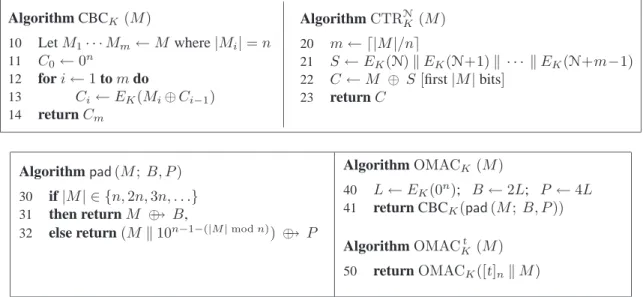
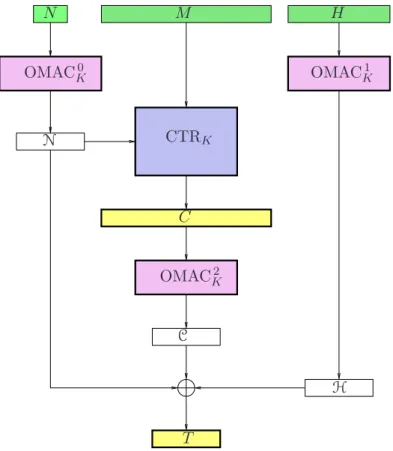
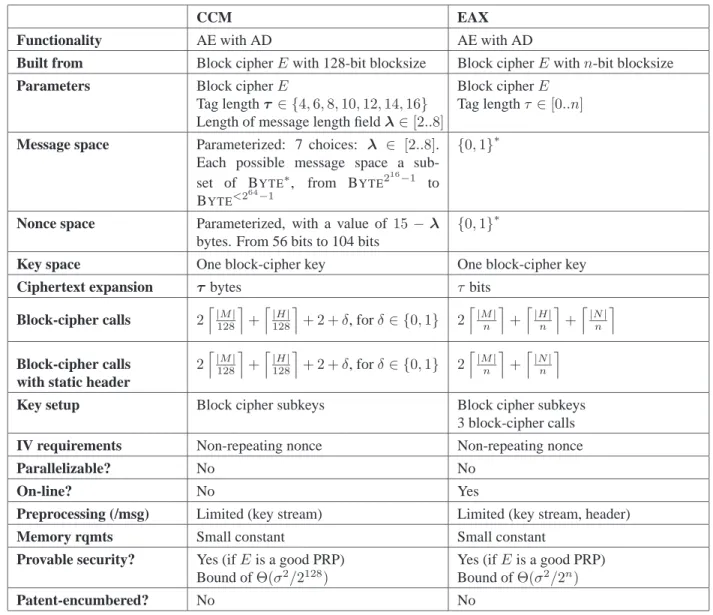
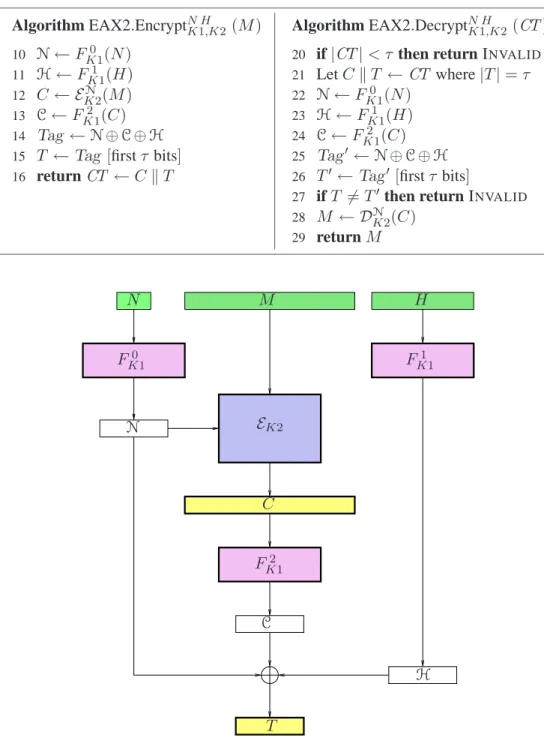
![Figure 6: Encryption and decryption under CCM[E, τ , λ]. The block cipher is E : Key × { 0, 1 } 128 → { 0, 1 } 128 and the tag length (in bytes) is τ ∈ { 4, 6, 8, 10, 12, 14, 16 } and the length-of-the-message-length-field (in bytes) is λ ∈ { 2, 3, 4, 5, 6](https://thumb-eu.123doks.com/thumbv2/1library_info/4733873.1618019/18.918.137.791.150.987/figure-encryption-decryption-cipher-length-length-message-length.webp)
![Figure 8: Adversary P attacking the privacy of IVE scheme Π using as subroutine adversary A attacking the privacy of Π = EAX2[Π, R n n , τ].](https://thumb-eu.123doks.com/thumbv2/1library_info/4733873.1618019/23.918.181.737.98.419/figure-adversary-attacking-privacy-subroutine-adversary-attacking-privacy.webp)
